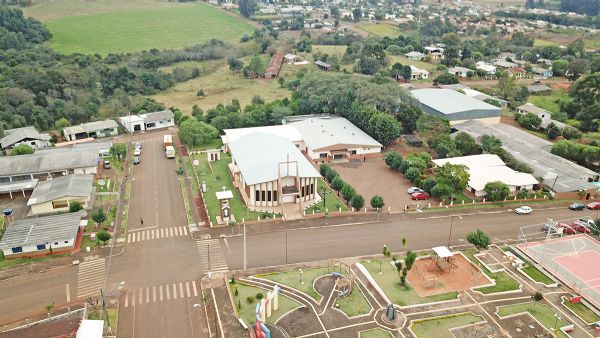Início » História

Com a revolução em 1894, comandada pelo ″Juca Tigre″ assim conhecido em nossa região, derivou várias situações e nomes de determinadas regiões que ainda se encontram vivas não só na lembranças, mas também na atualidade, como: Rio União onde as duas tropas se unirão; Rio Despedida onde as tropas se despediram; Rio do Tigre onde as tropas se encontraram e mataram tigres. Prosseguindo a marcha, avistaram uma bela vista, lugar alto onde dominaram de Boa Vista; dando continuidade a marcha avistaram um local onde a visão alcançava uma vasta região denominando a mesma de Espigão Alto, que com a emancipação política passou a denominar-se Espigão Alto do Iguaçu.
Formação Administrativa
Distrito criado com a denominação de Espigão Alto, pela lei municipal nº 19, de 31-12-1953, subordinado ao município de Laranjeiras do Sul.
Em divisão territorial datada de 1-VII-1960, o distrito de Espigão Alto, figura no município de Laranjeiras do Sul.
Assim permanecendo em divisão territorial datada de 31-XII-1963.
Pela lei estadual nº 5668, de 18-10-1967, o distrito de Espigão alto, foi transferido do município de Laranjeiras do Sul, para constituir o novo município de Campo Mourão.
Em divisão territorial datada de 31-XII-1968, o distrito de Espigão Alto, figura no município de Campo Mourão.
Pela lei estadual nº 6126, de 14-07-1970, o município de Campo Mourão tomou a denominação de Quedas do Iguaçu.
Em divisão territorial datada de 31-XII-1971, o distrito de Espigão Alto, figura no município Quedas do Iguaçu (ex-Campo Mourão).
Assim permanecendo em divisão territorial datada de 1993.
Elevado à categoria de município com a denominação de Espigão Alto do Iguaçu, pela lei estadual nº 10737, de 18-04-1994, desmembrado de Quedas do Iguaçu. Sede no atual distrito de Espigão Alto do Iguaçu (ex- Espigão Alto). Constituído do distrito sede. Instalado em 01-01-1997.
Em divisão territorial datada de 2001, o município é constituído do distrito sede.
Assim permanecendo em divisão territorial datada de 2007.
Transferência distrital
Pela lei estadual nº 5668, de 18-10-1967, transfere o distrito de Espigão alto do município de Laranjeiras do Sul para Campo Mourão.
Alteração toponímica distrital
Espigão alto para Espigão Alto do Iguaçu, alterado pela lei estadual nº 10737, de 18-04-1994.
We firmly believe that the internet should be available and accessible to anyone, and are committed to providing a website that is accessible to the widest possible audience, regardless of circumstance and ability.
To fulfill this, we aim to adhere as strictly as possible to the World Wide Web Consortium’s (W3C) Web Content Accessibility Guidelines 2.1 (WCAG 2.1) at the AA level. These guidelines explain how to make web content accessible to people with a wide array of disabilities. Complying with those guidelines helps us ensure that the website is accessible to all people: blind people, people with motor impairments, visual impairment, cognitive disabilities, and more.
This website utilizes various technologies that are meant to make it as accessible as possible at all times. We utilize an accessibility interface that allows persons with specific disabilities to adjust the website’s UI (user interface) and design it to their personal needs.
Additionally, the website utilizes an AI-based application that runs in the background and optimizes its accessibility level constantly. This application remediates the website’s HTML, adapts Its functionality and behavior for screen-readers used by the blind users, and for keyboard functions used by individuals with motor impairments.
If you’ve found a malfunction or have ideas for improvement, we’ll be happy to hear from you. You can reach out to the website’s operators by using the following email
Our website implements the ARIA attributes (Accessible Rich Internet Applications) technique, alongside various different behavioral changes, to ensure blind users visiting with screen-readers are able to read, comprehend, and enjoy the website’s functions. As soon as a user with a screen-reader enters your site, they immediately receive a prompt to enter the Screen-Reader Profile so they can browse and operate your site effectively. Here’s how our website covers some of the most important screen-reader requirements, alongside console screenshots of code examples:
Screen-reader optimization: we run a background process that learns the website’s components from top to bottom, to ensure ongoing compliance even when updating the website. In this process, we provide screen-readers with meaningful data using the ARIA set of attributes. For example, we provide accurate form labels; descriptions for actionable icons (social media icons, search icons, cart icons, etc.); validation guidance for form inputs; element roles such as buttons, menus, modal dialogues (popups), and others. Additionally, the background process scans all of the website’s images and provides an accurate and meaningful image-object-recognition-based description as an ALT (alternate text) tag for images that are not described. It will also extract texts that are embedded within the image, using an OCR (optical character recognition) technology. To turn on screen-reader adjustments at any time, users need only to press the Alt+1 keyboard combination. Screen-reader users also get automatic announcements to turn the Screen-reader mode on as soon as they enter the website.
These adjustments are compatible with all popular screen readers, including JAWS and NVDA.
Keyboard navigation optimization: The background process also adjusts the website’s HTML, and adds various behaviors using JavaScript code to make the website operable by the keyboard. This includes the ability to navigate the website using the Tab and Shift+Tab keys, operate dropdowns with the arrow keys, close them with Esc, trigger buttons and links using the Enter key, navigate between radio and checkbox elements using the arrow keys, and fill them in with the Spacebar or Enter key.Additionally, keyboard users will find quick-navigation and content-skip menus, available at any time by clicking Alt+1, or as the first elements of the site while navigating with the keyboard. The background process also handles triggered popups by moving the keyboard focus towards them as soon as they appear, and not allow the focus drift outside of it.
Users can also use shortcuts such as “M” (menus), “H” (headings), “F” (forms), “B” (buttons), and “G” (graphics) to jump to specific elements.
We aim to support the widest array of browsers and assistive technologies as possible, so our users can choose the best fitting tools for them, with as few limitations as possible. Therefore, we have worked very hard to be able to support all major systems that comprise over 95% of the user market share including Google Chrome, Mozilla Firefox, Apple Safari, Opera and Microsoft Edge, JAWS and NVDA (screen readers), both for Windows and for MAC users.
Despite our very best efforts to allow anybody to adjust the website to their needs, there may still be pages or sections that are not fully accessible, are in the process of becoming accessible, or are lacking an adequate technological solution to make them accessible. Still, we are continually improving our accessibility, adding, updating and improving its options and features, and developing and adopting new technologies. All this is meant to reach the optimal level of accessibility, following technological advancements. For any assistance, please reach out to
Pensando na acessibilidade da informação a todos os cidadãos, algumas ferramentas foram desenvolvidas no nosso site, sendo elas:

Para facilitar a leitura basta clicar no icone ”Tamanho da fonte / Modo Alto Contraste” localizado na parte inferior direita da tela, e depois no icone indicado na imagem ao lado, que a combinação das cores (branco e preto) irão oferecer um maior contraste.

Para aumentar ou diminuir a fonte do site basta clicar no icone ”Tamanho da fonte / Modo Alto Contraste” localizado na parte inferior direita da tela, e depois no icone indicado na imagem ao lado, que o tamanho da fonte aumenta ou diminui conforme você clicar!
Uma alternativa à leitura das informações disponíveis no Portal da Transparência, é a utilização da ferramenta "Leitor Selecção (Texto-para-Voz)", onde converte-se o texto em discurso, permitindo que o usuário ouça o conteúdo aqui disponível.
Por fim, para a tradução das informações disponíveis no portal em Língua Brasileira de Sinais - LIBRAS, sugerimos a utilização da ferramenta de código aberto e sem custo: Suite VLibras, a qual assegura o acesso ao portal para as pessoas que possuem redução ou ausência da capacidade auditiva. Mais informações sobre a ferramenta: Suite VLibras